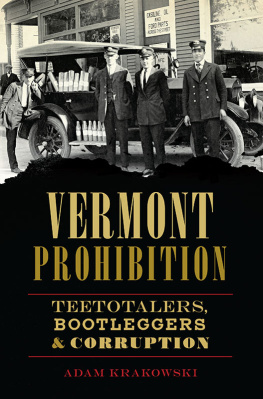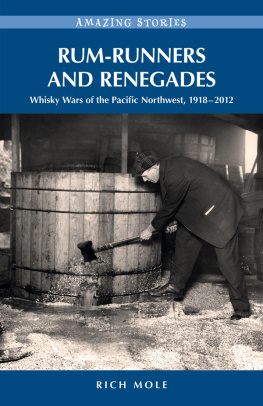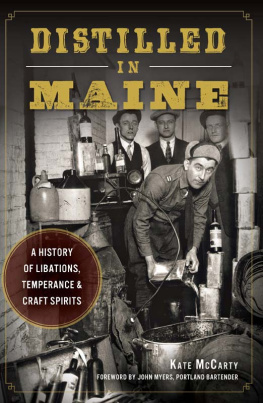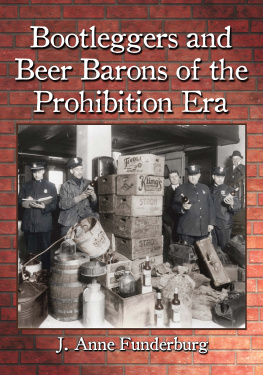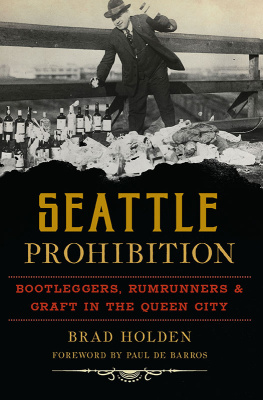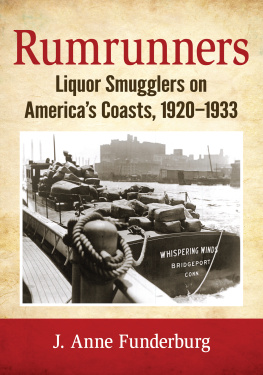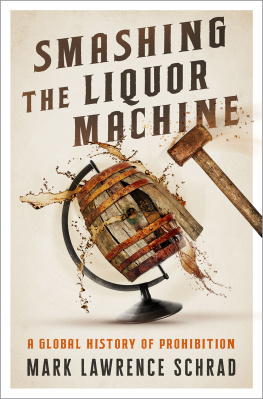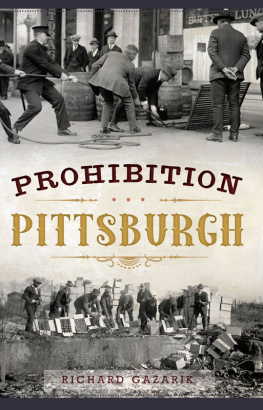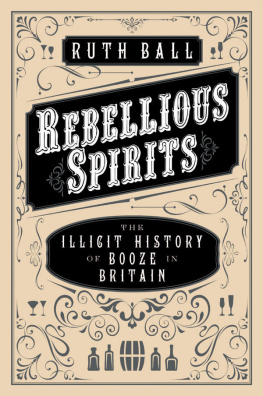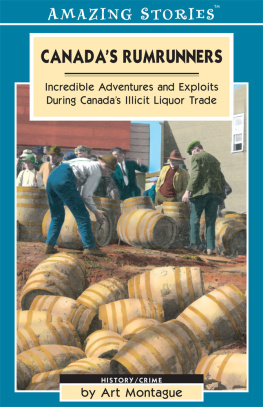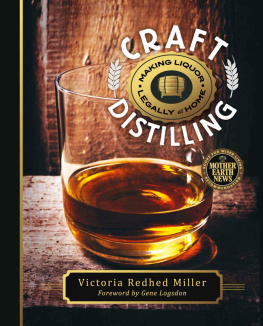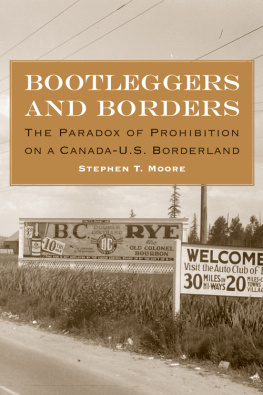


Published by American Palate
A Division of The History Press
Charleston, SC
www.historypress.net
Copyright 2016 by Adam Krakowski
All rights reserved
Cover: U.S. Customs agents at the border crossing in Swanton, Vermont. From left to right: Seldon Caldwel (immigration agent), Roy Seward (deputy collector of customs), Irving Bronson and Joe Walker. Courtesy of the Vermont Historical Society (Seward Woods Papers).
First published 2016
e-book edition 2016
ISBN 978.1.62619.930.9
Library of Congress Control Number: 2015956830
print edition ISBN 978.1.62585.463.6
Notice: The information in this book is true and complete to the best of our knowledge. It is offered without guarantee on the part of the author or The History Press. The author and The History Press disclaim all liability in connection with the use of this book.
All rights reserved. No part of this book may be reproduced or transmitted in any form whatsoever without prior written permission from the publisher except in the case of brief quotations embodied in critical articles and reviews.
For Noella,
Every Dream
CONTENTS
FOREWORD
There seems to be quite the contradiction between the hugely successful craft alcohol scene in Vermont today and our history with the temperance movement and Prohibition, but given the fact that over a century has elapsed, it is no surprise that things have changed. Time has a way of doing that to even the most ill-conceived ideas, and when Vermonters are involved, all bets are off. While the Vermont Department of Liquor Control (DLC) still stubbornly clings to some antiquated laws, throwbacks to the dark days of Prohibition, the legislature and past governors have chosen a more enlightened direction for the state. Is there more that can be done by the state to promote the flourishing craft alcohol movement, or will lawmakers, during a budgetary squeeze, kill the goose that lays the golden lager? It remains to be seen whether Vermont will embrace a future where it is a leader in the worldwide artisan food and drink movement and take its rightful place as the North American Bavariathe place where good things to eat and drink come fromor if it will miss this opportunity. As every state and all nations look for their niche in the global market, no one is better positioned than Vermont to stake that claim.
So how did we get here? Given our history as one of the first states to embrace the temperance movement and Prohibition, it would seem unlikely that we would become a world-renowned maker of beer. There was no brewing tradition in the state, and the last of the breweries we did have closed almost one hundred years to the day before the first of the new generation would open. Other places around the country had long-standing institutional breweries that struggled to weather out Prohibition, but when they began to make beer again, the equipment was there and so were the brewers. Here in Vermont, there was none of this. Yankee ingenuity, some stainless steel tanks left over from a declining dairy industry and some folks with a taste for good beer brought brewing back to Vermont. However, it wasnt just beer that emerged as locally produced alcohol; wineries also sprung up, and so did distillers.
Perhaps the least surprising has been the renaissance of the craft hard cider producers in the state. Even though the temperance movement shut down most of the alcohol trade in Vermont, there were always applesand left on its own, cider will turn hard all by itself. Along with the birth of the craft beer movement in the state, Joe Cerniglia of Springfield would open an apple winery in Proctorsville to make use of the excess apples from his orchard. His first batch of hard cider had a higher-than-expected alcohol content and made for a now legendary family Thanksgiving in my household, but thats a story for another time. As production issues were resolved, another product would emerge: Woodchuck Draft Cider. While it took a while for it to catch on here in the United States, draft cider has been popular in Europe for centuries. Today, we can now boast a number of highly regarded cider makers, and one would be hard pressed to find a more fitting place for the reemergence of craft cider.
Also rooted more firmly than beer in the traditions of the state are the distillers. Even though Vermont would embrace the temperance movement in the late 1800s, its location provided folks with ample opportunities to procure distilled spirits. During Prohibition, being located on the Canadian border made it possible for Vermonters to get their share as booze flowed south. During a recent renovation of a farmhouse, a trapdoor in the kitchen was discovered that most likely was used to hide the illicit trade of alcohol. The growth today in artisan distillers, and the numerous awards and accolades Vermonters have received, is reaffirming a place for our state in the hard alcohol world.
The American wine scene has always been dominated by the West Coast, but through the years, there have also been some successful wineries in the Northeast, most notably in New York. Today, the Northeast is too cold for the most common varietals of wine grapes, but with global warming, who knows what the next hundred years will bring. In the meantime, some very delicious grapes do very well in Vermont, and there have been award-winning wines produced in the state. The number of wineries in the Green Mountain State is always growing, and in a very surprising twist, two of the wineries have even added breweries to their production.
Vermonters have always had a tradition of supporting locally produced food and drink. Whereas other places around the country are just now discovering farmers markets and the locavore movement, the idea of supporting local producers is written into the DNA of Vermonters. So when Steve Mason at Catamount Brewing in White River Junction came to the market with beers that had the same flavors he fell in love with while traveling in Europe, Vermonters were not only willing to pay extra for these wonderful beers, but they also went out of their way to get them. Then there were Greg and Nancy Noonan, who came to the state with the idea of opening one of the first brewpubs on the East Coast in Burlington. This wasnt as easy as it sounds. In Vermont at the time, we still had on the books laws that prevented alcohol from being served at the same establishment where it was produced. This made the whole concept of a brewpub illegal in the state. Bill Mares, as a state representative from Burlington, along with Noonan helped get the laws changed, opening up the state to other brewers. It should also be noted that homebrewing was becoming more popular, with a relaxation of laws at the federal level, but there werent really any resources in place to help guide these budding brewers. Greg Noonan would pen one of the most concise brewing guides for the homebrewer and professional alike in Brewing Lager Beer. To this day, the book can be found in the reference libraries of most serious brewers.
The next serious legislative battle for brewers would come with the sale of beer above 8 percent alcohol by volume (ABV) outside the state liquor stores. The craft beer movement was embracing stronger and hoppier beers, and another throwback law from post-Prohibition prevented Vermont brewers from selling these beers in the states package stores. The Vermont DLC has always taken its lead from the legislature and, on a whole, has embraced the changes necessary to help the local alcohol scene flourish; however, very powerful neo-prohibitionist groups keep some antiquated laws on the books and prevent changes that would be both supportive and nurturing to this exciting young industry. Yet when the enforcement wing of the DLC is pictured shooting pistols on a firing line, one has to ask: When was the last time the DLC enforcers kicked down the door of an establishment serving alcohol with their weapons drawn? Prohibition?
Next page
